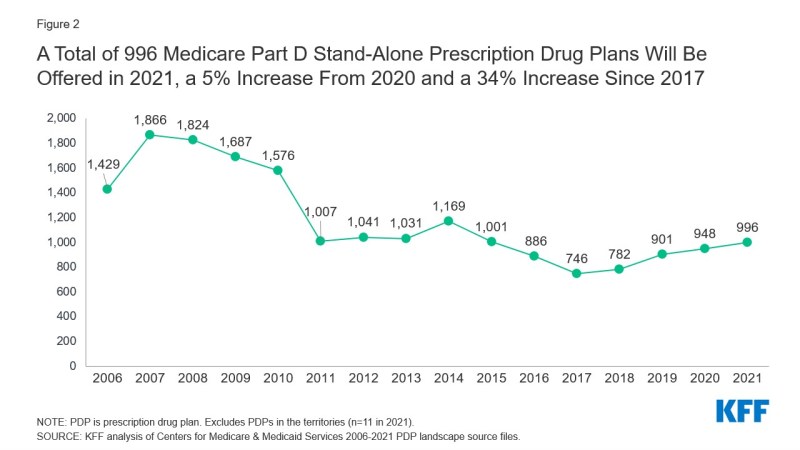Medicare Part D: A First Look at Medicare Prescription Drug Plans in 2021
During the Medicare open enrollment period from October 15 to December 7 each year, beneficiaries can enroll in a plan that provides Part D drug coverage, either a stand-alone prescription drug plan (PDP) as a supplement to traditional Medicare, or a Medicare Advantage prescription drug plan (MA-PD), which covers all Medicare benefits, including drugs. Among the 46 million Part D enrollees in 2020, 20.2 million (44%) are in PDPs and 19.3 million (41%) are in MA-PDs (excluding the 7.0 million (15%) in employer-only group PDPs and MA-PDs). This issue brief provides an overview of Medicare Part D drug plans that will be available in 2021 and key trends over time.
Part D Plan Availability
The Average Medicare Beneficiary Has a Choice of Nearly 60 Medicare Plans with Part D Drug Coverage in 2021, Including 30 Medicare Stand-alone Drug Plans and 27 Medicare Advantage Drug Plans
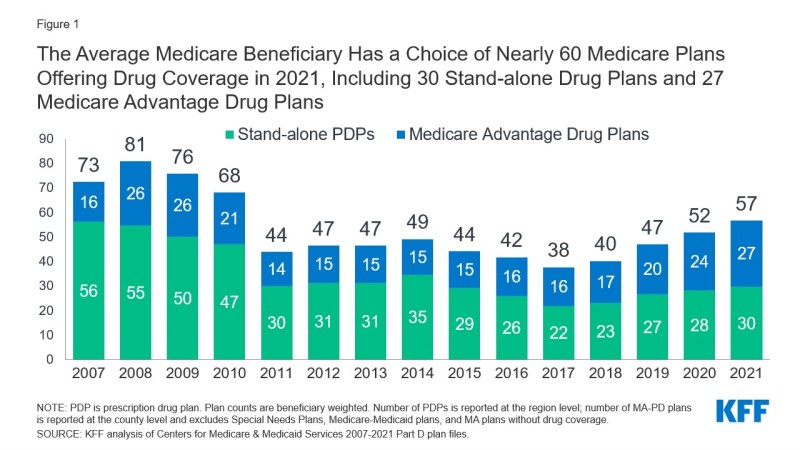
Figure 1: The Average Medicare Beneficiary Has a Choice of Nearly 60 Medicare Plans Offering Drug Coverage in 2021, Including 30 Stand-alone Drug Plans and 27 Medicare Advantage Drug Plans
A larger number of Part D plans will be offered in 2021 than in recent years. The average Medicare beneficiary will have a choice of 30 stand-alone PDPs in 2021, two more PDP options than in 2020, and eight more than in 2017, a 36% increase (Figure 1). Although the number of PDP options in 2021 is half of what it was at the peak in 2007 (when there were 56 PDP options, on average), this is the fourth year in a row with an increase in the average number of stand-alone drug plan options.
In 2021, beneficiaries will also have access to 27 MA-PDs, on average, a 71% increase in MA-PD options since 2017 (excluding Medicare Advantage plans that do not offer the drug benefit and plans not available to all beneficiaries; overall, an average of 33 Medicare Advantage plan options will be available in 2021).
Based on September 2020 enrollment, 8 out of 10 PDP enrollees (80%) in 2021 are projected to be in PDPs operated by just four firms: UnitedHealth, Centene (which acquired WellCare in 2020), Humana, and CVS Health (based on PDP enrollment as of September 2020). All four firms offer PDPs in all 34 PDP regions in 2021.
A total of 996 PDPs will be offered in the 34 PDP regions in 2021 (plus another 11 PDPs in the territories), an increase of 48 PDPs (5%) over 2020, and 250 more PDPs (a 34% increase) since 2017 (Figure 2). This increase is primarily due to the Trump Administration’s elimination of the “meaningful difference” requirement for enhanced benefit PDPs offered by the same organization in the same region. Eliminating this requirement means that PDP sponsors no longer have to demonstrate that their enhanced PDPs offered in the same region are meaningfully different in terms of enrollee out-of-pocket costs. In 2021, 62% of PDPs (618 plans) will offer enhanced Part D benefits—a 60% increase in the availability of enhanced-benefit PDPs since 2017, when just over half of PDPs (387 plans) offered enhanced benefits.
The number of PDPs per region in 2021 will range from 25 PDPs in Alaska to 35 PDPs in Texas and will be the same or higher in 32 of the 34 PDP regions compared to 2020 (see map, Table 1).
Part D Premiums
The Estimated Average Monthly Premium for Medicare PDPs Is Projected to Increase by 9% to $41 in 2021, Based on Current Enrollment
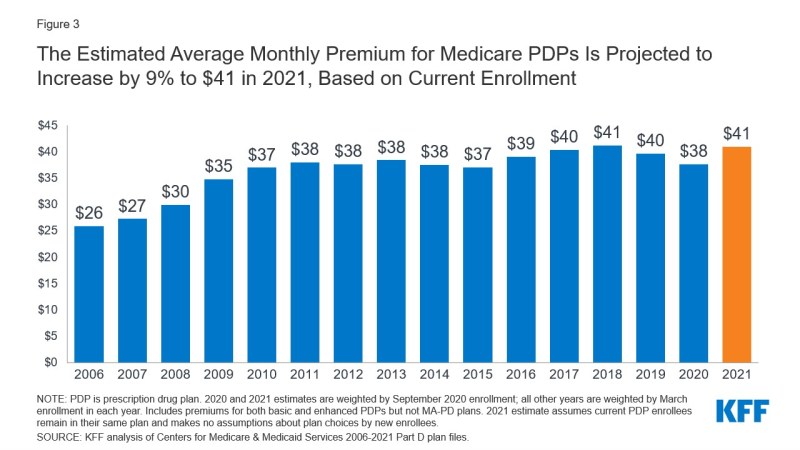
Figure 3: The Estimated Average Monthly Premium for Medicare PDPs Is Projected to Increase by 9% to $41 in 2021, Based on Current Enrollment
The estimated national average monthly PDP premium for 2021 is projected to increase by 9% to $41, from $38 in 2020, weighted by September 2020 enrollment (Figure 3). It is likely that the actual average weighted premium for 2021, after taking into account enrollment choices by new enrollees and plan changes by current enrollees, will be somewhat lower than the estimated average. CMS reported that the average premium for basic Part D coverage offered by PDPs and MA-PDs will be an estimated $30 in 2021. Our premium estimate is higher because it is based on PDPs only (excluding MA-PDs) and includes PDPs offering both basic and enhanced coverage (enhanced plans, which account for 62% of all PDPs in 2021, have higher premiums than basic plans, on average).
Average Monthly Premiums for the 21 National Part D Stand-alone PDPs Are Projected to Range from $7 to $89 in 2021, with Higher Average Premiums for Enhanced Benefits and Zero-Deductible PDPs
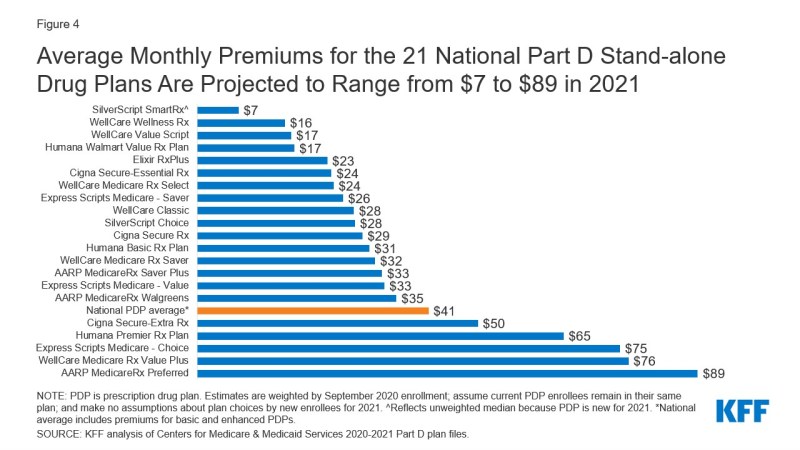
Figure 4: Average Monthly Premiums for the 21 National Part D Stand-alone Drug Plans Are Projected to Range from $7 to $89 in 2021
PDP premiums will vary widely across plans in 2021, as in previous years (Figure 4, Table 2). Among the 21 PDPs available nationwide, average premiums will range from a low of $7 per month for SilverScript SmartRx to a high of $89 per month for AARP MedicareRx Preferred.
Changes to premiums from 2020 to 2021, averaged across regions and weighted by 2020 enrollment, also vary widely across PDPs, as do the absolute amounts of monthly premiums for 2021.
- The 1.9 million non-LIS enrollees in the largest PDP, CVS Health’s SilverScript Choice (which had a total of 3.9 million enrollees in 2020, including those receiving low-income subsidies) will face a modest $1 (2%) decrease in their average monthly premium, from $29 in 2020 to $28 in 2021.
- In contrast, the 1.8 million non-LIS enrollees in the second largest PDP, AARP MedicareRx Preferred, will face a $10 (12%) increase in their average monthly premium between 2020 and 2021, from $79 to $89. This is the highest monthly premium among the national PDPs in 2021.
- The 1.3 million non-LIS enrollees in the fourth largest PDP, Humana Premier Rx, will see a $7 (13%) increase in their monthly premium, from $58 in 2020 to $65 in 2021.
Most Part D stand-alone drug plans in 2021 (62% of PDPs) will offer enhanced benefits for a higher monthly premium. Enhanced benefits can include a lower (or no) deductible, reduced cost sharing, or a higher initial coverage limit than under the standard benefit design. The average premium in 2021 for enhanced benefit PDPs is $51, which is 55% higher than the monthly premium for PDPs offering the basic benefit ($33) (weighted by September 2020 enrollment).
In 2021, a large majority of PDPs (86%) will charge a deductible, with most PDPs (67%) charging the standard amount of $445 in 2021. Across all PDPs, the average deductible in 2021 will be $345 (weighted by September 2020 enrollment). The average monthly premium in 2021 for PDPs that charge no deductible is $88, nearly three times the monthly premium for PDPs that charge the standard deductible ($34) or a partial deductible ($31) (weighted by September 2020 enrollment).
Nearly 8 in 10 Part D Stand-alone Drug Plan Enrollees Without Low-income Subsidies Will Pay Higher Premiums in 2021 If They Stay in Their Current Plan
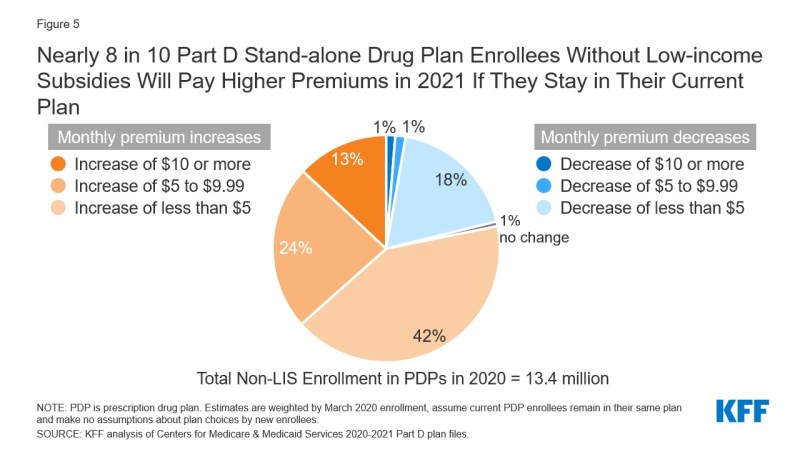
Figure 5: Nearly 8 in 10 Part D Stand-alone Drug Plan Enrollees Without Low-income Subsidies Will Pay Higher Premiums in 2021 If They Stay in Their Current Plan
Most (78%, or 10 million) of the 13.4 million Part D PDP enrollees who are responsible for paying the entire premium (which excludes Low-Income Subsidy (LIS) recipients) will see their monthly premium increase in 2021 if they stay in their same plan, while 2.8 million (21%) will see a premium reduction if they stay in their same plan (Figure 5).
Nearly 2 million non-LIS enrollees (13%) will see a premium increase of $10 or more per month, while significantly fewer (0.2 million non-LIS enrollees, or 1%) will see a premium reduction of the same magnitude. One-third (34%) of non-LIS enrollees (4.6 million) are projected to pay monthly premiums of at least $60 if they stay in their current plans, and more than 230,000 (2% of non-LIS enrollees) are projected to pay monthly premiums of at least $100.
The Average Monthly Part D Premium in 2021 for the Subset of Enhanced Stand-alone Drug Plans Covering Insulin at a $35 Monthly Copay Is Substantially Higher Than Premiums for Other PDPs
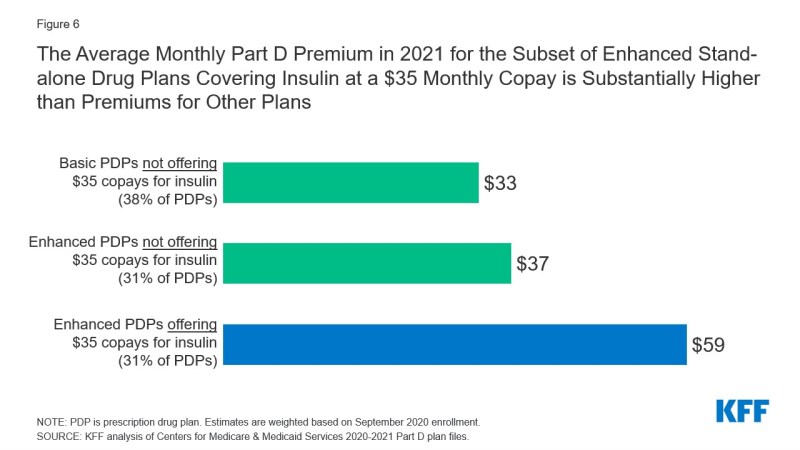
Figure 6: The Average Monthly Part D Premium in 2021 for the Subset of Enhanced Stand-alone Drug Plans Covering Insulin at a $35 Monthly Copay is Substantially Higher than Premiums for Other Plans
New for 2021, beneficiaries in each state will have the option to enroll in a Part D plan participating in the Trump Administration’s new Innovation Center model in which enhanced drug plans cover insulin products at a monthly copayment of $35 in the deductible, initial coverage, and coverage gap phases of the Part D benefit. Participating plans do not have to cover all insulin products at the $35 monthly copayment amount, just one of each dosage form (vial, pen) and insulin type (rapid-acting, short-acting, intermediate-acting, and long-acting).
In 2021, a total of 1,635 enhanced Part D plans will participate in this model, which represents just over 30% of both PDPs (310 plans) and MA-PDs (1,325 plans) available in 2021, including plans in the territories. Between 8 and 10 enhanced PDPs in each region are participating in the model, in addition to multiple MA-PDs (see map). The average premium in 2021 for the subset of enhanced PDPs participating in the insulin $35 copay model ($59) is nearly twice as high as the monthly premium for basic PDPs ($33) and 61% higher than the average premium for enhanced PDPs that are not participating in the model ($37) (weighted by September 2020 enrollment).
Part D Cost Sharing
Part D Enrollees Will Pay Much Higher Cost-Sharing Amounts for Brands and Non-preferred Drugs Than For Drugs on a Generic Tier, and a Mix of Copays and Coinsurance for Different Formulary Tiers
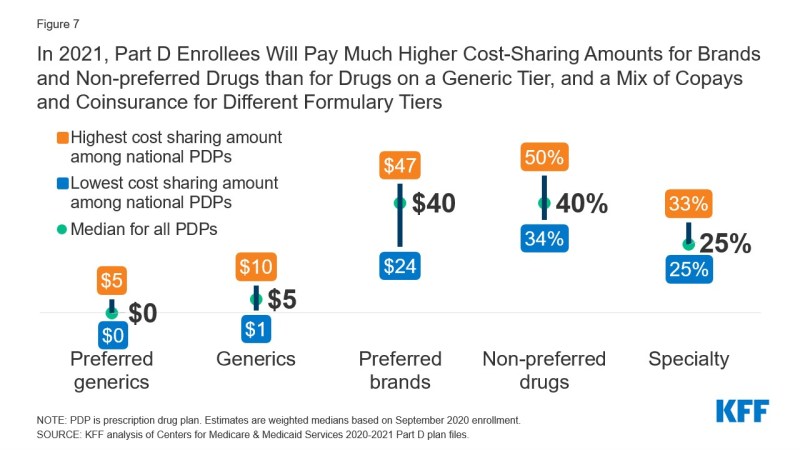
Figure 7: In 2021, Part D Enrollees Will Pay Much Higher Cost-Sharing Amounts for Brands and Non-preferred Drugs than for Drugs on a Generic Tier, and a Mix of Copays and Coinsurance for Different Formulary Tiers
In 2021, as in prior years, Part D enrollees will face much higher cost-sharing amounts for brands and non-preferred drugs (which can include both brands and generics) than for drugs on a generic tier, and a mix of copayments and coinsurance for different formulary tiers (Figure 7). The typical five-tier formulary design in Part D includes tiers for preferred generics, generics, preferred brands, non-preferred drugs, and specialty drugs. Among all PDPs, median standard cost sharing in 2021 is $0 for preferred generics and $5 for generics (an increase from $4 in 2020), $40 for preferred brands (a decrease from $42 in 2020), 40% coinsurance for non-preferred drugs (an increase from 38% in 2020; the maximum allowed is 50%), and 25% coinsurance for specialty drugs (the same as in 2020; the maximum allowed is 33%).
Among the 21 national PDPs, 13 PDPs, covering 9.3 million enrollees as of September 2020, are increasing cost-sharing amounts for drugs on at least one formulary tier between 2020 and 2021 (Table 3). Five PDPs are increasing copayments for generics, with increases ranging from $1 to $4; six PDPs are increasing copayments for preferred brands, with increases ranging from $3 to $10; and 10 PDPs are increasing coinsurance for non-preferred drugs, with increases ranging from 2 percentage points (e.g., from a 38% coinsurance rate to 40%) to 14 percentage points (e.g., from a 35% coinsurance rate to 49%).
Low-Income Subsidy Plan Availability
In 2021, 259 Part D Stand-Alone Drug Plans Will Be Premium-Free to Enrollees Receiving the Low-Income Subsidy (Benchmark Plans)
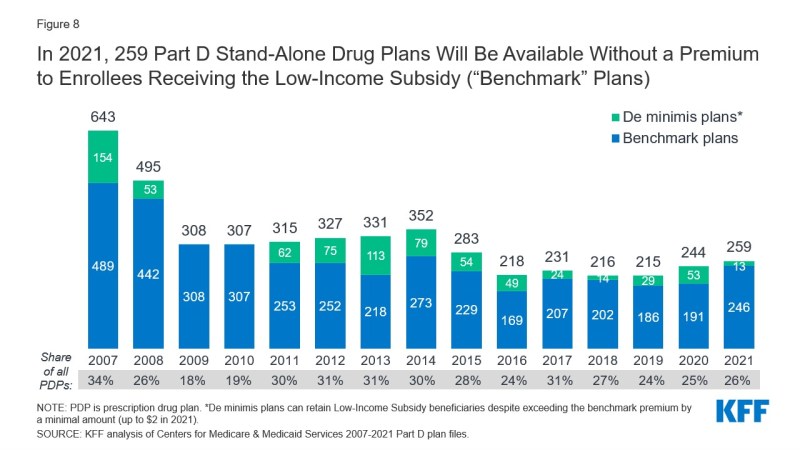
Figure 8: In 2021, 259 Part D Stand-Alone Drug Plans Will Be Available Without a Premium to Enrollees Receiving the Low-Income Subsidy (“Benchmark” Plans)
In 2021, a larger number of PDPs will be premium-free benchmark plans—that is, PDPs available for no monthly premium to Medicare Part D enrollees receiving the Low-Income Subsidy (LIS)—than in recent years, with 259 premium-free benchmark plans, or roughly a quarter of all PDPs in 2021 (Figure 8). Through the Part D LIS program, enrollees with low incomes and modest assets are eligible for assistance with Part D plan premiums and cost sharing. As of 2020, approximately 13 million Part D enrollees are receiving LIS, including 6.7 million (52%) in PDPs and 6.1 million (48%) in MA-PDs.
On average (weighted by Medicare enrollment), LIS beneficiaries have eight benchmark plans available to them for 2021, or about one-fourth the average number of PDP choices available overall. All LIS enrollees can select any plan offered in their area, but if they enroll in a non-benchmark plan, they must pay some portion of their chosen plan’s monthly premium. In 2021, 10% of all LIS PDP enrollees who are eligible for premium-free Part D coverage (0.6 million LIS enrollees) will pay Part D premiums averaging $33 per month unless they switch or are reassigned by CMS to premium-free plans.
The number of benchmark plans available in 2021 will vary by region, from five to 10 (see map). In 2020, 89% of the 6.6 million LIS PDP enrollees are projected to be in PDPs operated by five firms: CVS Health, Centene, Humana, UnitedHealth, and Cigna (based on 2020 enrollment).
Discussion
Our analysis of the Medicare Part D stand-alone drug plan landscape for 2021 shows that millions of Part D enrollees without low-income subsidies will face premium and other cost increases in 2021 if they stay in their current stand-alone drug plan. There are more plans available nationwide in 2021, with Medicare beneficiaries having 30 PDP choices during this year’s open enrollment period, plus 27 Medicare Advantage drug plan options. Most Part D PDP enrollees who remain in the same plan in 2021 will be in a plan with the standard $445 deductible and will face much higher cost sharing for brands than for generic drugs, including as much as 50% coinsurance for non-preferred drugs.
Some Part D enrollees who choose to stay in their current plans may see lower premiums and other costs for their drug coverage, but nearly 8 in 10 non-LIS enrollees will face higher premiums if they remain in their current plan, and many will also face higher deductibles and cost sharing for covered drugs. Some beneficiaries might find the best coverage and costs for their specific medications in a plan with a relatively low premium, while for other beneficiaries, a higher-premium plan might be more suitable. Because Part D plans vary in a number of ways that can have a significant effect on an enrollee’s out-of-pocket spending, beyond the monthly premium, all Part D enrollees could benefit from the opportunity to compare plans during open enrollment.
Juliette Cubanski is with KFF.
Anthony Damico is an independent consultant.
| Methods |
| This analysis focuses on the Medicare Part D stand-alone prescription drug plan marketplace in 2021 and trends over time. The analysis includes 20.2 million enrollees in stand-alone PDPs, as of March 2020. The analysis excludes 17.4 million MA-PD enrollees (non-employer), and another 4.6 million enrollees in employer-group only PDPs and 2.3 million in employer-group only MA-PDs for whom plan premium and benefits data are unavailable.
Data on Part D plan availability, enrollment, and premiums were collected from a set of data files released by the Centers for Medicare & Medicaid Services (CMS): – Part D plan landscape files, released each fall prior to the annual enrollment period – Part D plan and premium files, released each fall – Part D plan crosswalk files, released each fall – Part D contract/plan/state/county level enrollment files, released on a monthly basis – Part D Low-Income Subsidy enrollment files, released each spring – Medicare plan benefit package files, released each fall In this analysis, premium estimates are weighted by September 2020 enrollment unless otherwise noted. Percentage increases are calculated based on non-rounded estimates and in some cases differ from percentage calculations calculated based on rounded estimates presented in the text. |

